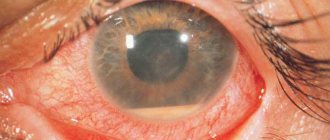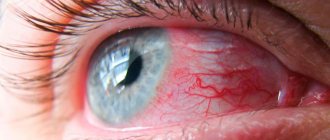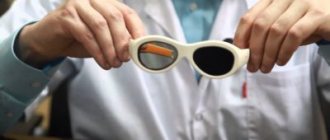How can myopia be cured?
Myopia is the most common refractive error, affecting approximately 1.5 billion people worldwide, representing about 23% of the population. Scientists say that in 30 years, half of the world's people will have some degree of myopia. What is this connected with? There are a number of factors that contribute to vision deterioration. These include:
The content of the article
What is myopia
- Causes of myopia
bad ecology;
It is practically impossible to prevent myopia if it is caused by a hereditary predisposition, but today it is possible to stop the development of the disease and cure it. There are several main methods of treating myopia:
- doing eye exercises;
- taking courses in hardware procedures;
- taking vitamin complexes;
- vision correction with glasses and contact lenses;
- laser treatment;
- refractive surgery.
The last two methods allow you to get rid of myopia forever or for a very long time, but they are prescribed only to adult patients. Why can’t vision correction surgery be performed on children? To answer this and other questions related to the treatment of myopia, it is necessary to describe this disease in more detail.
What else can you do to improve your vision if you are nearsighted?
First of all, do not forget about control: visit an ophthalmologist more often, check the dynamics of the disease, and carry out an ultrasound measurement of the length of the eye every six months.
If you wear glasses, adjust the diopters if you notice any changes in vision, and when starting to treat myopia, take into account the degree of the disease and your lifestyle.
Remember about prevention, it also contributes to a speedy recovery:
- do special eye exercises, wear corrective glasses if you feel the need;
- take medications that can relieve spasms of the eye muscles;
- strengthen the entire body as a whole, and not just the eyes, go to the pool and get a massage whenever possible;
- eat right, without limiting yourself in vitamins and microelements;
- consult with experts when making important decisions.
When discussing how to restore vision in case of myopia, do not discount traditional medicine. Among the mass of recipes there are quite sensible suggestions. Prepare various jellied meats, cartilage, and broths more often - they are all useful for strengthening the connective tissue of the eyes. And don’t forget about vitamin-rich vegetables and berries: blueberries, carrots, etc.
There are many recipes for herbal infusions and teas to maintain vision, but complex treatment that will help get rid of myopia can only be prescribed by a doctor. Each correction method has its own contraindications, and only an experienced ophthalmologist will help you avoid serious problems and complications.
To the question “can myopia be cured?” Trust only experts, clinics with a solid reputation, let your eyes receive the best treatment. Be healthy!
What is myopia?
Myopia is a refractive error in which distance vision is impaired while maintaining vision at close distances. The higher the degree of myopia, the shorter the distance of good vision. In the absence of vision problems, a person sees the world in all details. He can see a car license plate from a fairly far distance, the inscription on an advertising poster, etc. A nearsighted person is not able to distinguish small details. For example, the crown of a tree is perceived by him as a solid green mass. In severe myopia, even the facial features of an interlocutor who is a meter away from you appear blurry.
Aerobics for the eyes
You can improve your vision on your own with the help of special eye exercises.
These exercises are not complicated, but they can relieve muscle spasms and tone the blood vessels of the eyes, which helps restore vision.
Exercises that will help cure this disease:
- Up down. In order to improve vision, you need to repeat this exercise ten times daily. Look up and immediately down, then right and left. Close your eyes for a few moments.
- Circles and eights. Rotating your eyes, drawing round shapes with your gaze, is beneficial for the muscles of the visual organs. Such circles and eights should be done fifteen times a day.
- Label. On the window glass at eye level, draw a dot half a centimeter in diameter. Position yourself near a window at a distance of 30 centimeters. Look at the dot, then look at any object in the yard that is also at eye level. Repeat several times. The first week this exercise should be performed for five minutes, then you can do it longer. The main thing is that the sun does not hit the window, and excessive light does not strain the eyes.
- Through your fingers. Shake your hands and spread your fingers wide. You need to keep your palms about ten centimeters from your face. Turn your head from side to side, carefully looking through your fingers at surrounding objects. To improve the condition of your eyes, this exercise should be done every day for three minutes.
- Pendulum. A homemade weight will help restore eye health. You can tie a ring, button or other small object to a thread. Ask a relative to swing the pendulum at a distance of 40 centimeters from your eyes. You should sit opposite the window. For 30 seconds, keep your gaze on the weight without turning your head. Then look out the window, trying to see objects in the distance. Repeat this three times. It is important that, as in the “Mark” exercise, the sun does not shine through the window.
- Check mark. To get rid of myopia, you should repeat this exercise ten times daily. You need to sit a meter away from the wall, facing it. Look at the upper left corner, then, without moving your head, lower your gaze and close your eyes, completely relaxing. Now look at the top right corner. Repeat the exercise in reverse order. Ten such repetitions must be done. It turns out that with your gaze you draw the letter “V” from left to right and from right to left.
- Clock face. You can treat myopia with a wall clock or alarm clock. We take a watch that is comfortable to hold and move our gaze clockwise, noticing the signs on the dial, even tiny seconds. When you "pass" the dial three times, change direction. To complicate the gymnastics, you can hold the clock at arm's length or not remove it from the wall at all.
And the most simple, but at the same time pleasant and effective exercise for the eyes is palming. It was developed more than a century ago by Dr. William Bates. In order to perform gymnastics, you will need a table and a chair.
You need to act like this:
- Sit with your hands on the table and your back straight to improve blood flow.
- Shake your hands, rub your palms, form your hands into boats and bring them to your eyes.
- Place them so that the little fingers meet on the bridge of the nose, and the inside of the “boats” falls directly on the eyes.
- The edges of the palms should be pressed against the face, but there is no need to press too hard.
- In the dark, you should think about pleasant things: the sea breeze, the foamy surf, the warm sand, the luxurious gardens.
Palming, despite its simplicity, makes it possible to relax all parts of the eye. There are also water procedures, a kind of “water aerobics” for the eyes. They should start with contrast baths.
You need to take two large bowls and fill one of them with hot water, the other with cold. With your eyes closed, lower your face into a bowl of warm water, then into the next one. You should keep your face in the water for ten seconds. The final step should be a warm dip. Such contrast procedures relieve eye strain and can improve vision. Did this water procedure not seem very pleasant? Try contrasting compresses. For 20 seconds, you need to put napkins soaked in warm water over your eyes, then change them to cold ones, and return the warm ones for another 20 seconds. You can also make warm, relaxing compresses from tea bags, chamomile or rosemary infusions.
Degrees of myopia
There are three degrees of myopia:
- Weak, or first, with a vision deviation within 3 diopters - from −0.2 to −3D. The patient sees without correction means at close and medium distances. Glasses are rarely required, for example when driving a car.
- Average. The myopia index ranges from −3 to −6D. The distance of good vision is approximately 30 cm. You have to wear glasses or contact lenses constantly. They are removed only before reading.
- High, or strong, which is characterized by a deviation of more than −6D. A person sees practically nothing further than 10 cm from the face. At this degree, the likelihood of retinal rupture and detachment is high.
Myopia does not always go through all these stages. Its indicator may not change throughout life. There is also progressive myopia, when vision drops by 1 or more diopters per year.
Features of myopia
Experts distinguish several degrees of the disease: weak (up to -3 diopters), medium (from -3 to -6 diopters) and high - more than -6 diopters.
According to the clinical course, myopia is distinguished between static and progressive. Static is characterized by the fact that vision is in a fixed state and can be easily corrected. In turn, progressive myopia, like farsightedness, occurs with virtually no symptoms and most often stops growing at the moment when the body as a whole stops growing. However, this may not happen, then the situation becomes more complicated and requires additional intervention from specialists.
Causes of myopia
The main cause of myopia is abnormal growth of the eye, its excessive increase in length. The components of the optical system remain in the same place, but its refractive power changes. After refraction, light rays end up in front of the retina, not on it. Because of this, near vision is preserved, but distance vision is impaired. In a nearsighted person with a high degree of disease, the eye diameter can be 30 mm, while the norm is 23-24 mm. What influences the process of eyeball formation? There are several main reasons for their improper growth:
- Genetic predisposition. Children with nearsighted parents are more likely to suffer from this disease. Usually the eyes begin to develop incorrectly due to weakness of the connective tissue, sclera, etc. This manifests itself 3-4 years after birth.
- Lack of visual hygiene. Myopia often occurs at the age of 10-12 years, when eye strain increases at school. Overstrain of the eye muscles can lead to the development of myopia. If a child at this age does not do eye exercises, eats poorly, and rarely gets outdoors, the risk of vision deterioration increases. It is even higher if there is a genetic predisposition to the disease.
- Increased intraocular pressure. This factor is associated with impaired formation of the eyeballs during fetal development. This form of myopia occurs quite rarely - in 1-2% of cases.
Another cause of myopia is imperfection of the optical system. Several eye structures are involved in the refraction of light rays, the main ones being the lens and cornea. Their irregular shape can cause light to collect in front of the retina after refraction. Injuries, eye diseases and other factors lead to curvature of the cornea and lens.
The risk of developing myopia also increases with:
- lack of certain vitamins and minerals;
- complications of infectious and inflammatory eye diseases;
- hormonal changes;
- traumatic brain injuries.
Treatment without surgery at home
To maintain visual acuity, stabilize the condition and improve visibility in myopia, you should normalize your diet by including the necessary vitamins, minerals and antioxidants. Folk remedies have a beneficial effect on the eyes, the feasibility of which and their benefits/harms should be discussed with a specialist.
Diet
The development of myopia and deterioration of vision is influenced by poor nutrition. To normalize and improve the condition, it is necessary to consume protein contained in fish, meat and eggs. Vegetables and fruits that are beneficial for the organ of vision are recommended to be eaten raw. During heat treatment, beneficial substances are lost.
Important vitamins for myopia are A, D, E, B. Minerals are also necessary - copper, chromium, zinc and magnesium.
If you have myopia, you should exclude coffee, strong tea, cocoa, sausages, and canned goods.
Blueberry
Berry extract is part of many vitamin complexes: Myrtilene forte, Blueberry forte, Blueberry. The berries themselves, fresh or frozen, are also useful. They contain bioflavonoids, which have an antioxidant effect, reduce damage to the organ of vision and the body as a whole by free radicals.
They improve visual acuity, restore the light-sensitive pigment rhodopsin, stimulate microcirculation and nutrition of eye tissue. Additionally, they make the retinal capillaries elastic and strong.
You can take 100 g per day to improve vision, brew with boiling water in the proportion of 2 tbsp per 600 ml of hot water. l. berries or taken in the form of tablets and capsules. The course of therapy is long - 1-3 months.
Carrot
Source of carotenoids and vitamin A, beneficial for vision. Helps improve visual acuity, supports retinal functionality and rhodopsin synthesis. It also protects the lens from destruction.
Vitamins are better absorbed in combination with fats, so you should add 1 tbsp to 200 ml of carrot juice. l. olive oil. Take it every day for a long time.
Ginkgo biloba
The plant, which improves blood supply and microcirculation of eye tissue, is an antioxidant. It is sold in pharmacies in dry form and is included in the preparations: Ginkum, Ginkgo biloba, Bilobil.
In ophthalmological practice it is used to improve nutrition of the oculomotor and ciliary muscles, increase visual acuity, and ensure blood flow to the retina.
Polyunsaturated fatty acids
For normal eye function, the body requires a daily intake of polyunsaturated fatty acids, or omega-3s. Their source is sea fish and algae. Also included in dietary supplements - Doppelgerz Omega-3, Omega-3-6-9, Omeganol, Fish oil.
Additionally, it prevents the development of atherosclerosis.
Calcium
To inhibit the growth of the eye in length, it is necessary to strengthen the sclera. One way to do this is to consume dairy products and other foods or supplements that contain calcium.
Eyebright
Medicinal raw materials are sold in pharmacies and help with decreased visual acuity, eyeball injuries, and various inflammatory processes. Eyebright is used as a decoction and lotions. For this, 2 tbsp. l. pour dry raw materials with a glass of boiling water and leave for 25 minutes.
Bee products
Propolis and honey are actively used to prepare lotions, infusions and eye drops at home. When using them, you must make sure that you are not allergic to bee products.
Propolis in the amount of 1 tsp. dissolve in a glass of boiled water, filter the resulting solution and store in a dark, cool place, for example, a floor cabinet. The resulting product is used in the form of compresses or eye drops. Before use, you should consult an ophthalmologist.
How should myopia be treated?
How can myopia be cured? It is impossible to correct the structure of the eyeball with glasses, lenses, exercises and hardware procedures. All these measures help prevent the progression of myopia and compensate for the refractive error, that is, ensure a full life with good vision in the presence of existing visual pathology. You can get rid of this problem through surgery. Today, laser methods for treating myopia are becoming increasingly popular.
Stopping progression with surgery
Indications for surgical treatment are as follows:
- Progressive elongation of the eye from front to back with axial myopia;
- High degree of myopia (above -6 diopters), complicated by intraocular hypertension, hemorrhages or retinal pathology;
- Malignant course of the disease.
The main types of operations that can stop the progression of the disease are scleroplasty and refractive lens replacement.
How is myopia treated with laser methods?
Using laser technology, not only myopia is treated, but also other refractive errors: hypermetropia, astigmatism, presbyopia. Laser correction is prescribed only to adults. Before the age of 18, the eyeballs may change in size, which will affect the degree of myopia. Thus, such an operation performed in childhood may be ineffective.
Adults resort to this treatment method in the following cases:
- There is no desire to wear glasses or contact lenses. When wearing them, you have to visit the ophthalmologist more often, select new models of optics, and adjust their optical power.
- Professional activity does not allow the use of optics for correction. We are talking about firefighters, military and other specialists.
- When playing sports. Today, contact optics are produced that allow you to lead an active lifestyle - running, cycling, playing sports. However, professional athletes prefer to get rid of such a problem as myopia forever.
Exercise restrictions
Most ophthalmologists use various eye drops during treatment; in particularly difficult cases, surgery is indicated. But there are methods to restore vision without the use of medications or surgery.
Special exercises are recognized as the most effective ways to restore vision today. However, high myopia is very rarely treatable at home. In this case, only correction helps. It is also quite difficult to correct hereditary myopia.
When is laser correction of myopia contraindicated?
This treatment method is very safe, but it is not available to everyone. At the same time, the list of contraindications is quite extensive. There are temporary limited and absolute. Among the first:
- infectious and inflammatory eye diseases - keratitis, uveitis, blepharitis, conjunctivitis, etc.;
- dry eye syndrome;
- non-closure of eyelids - lagophthalmos;
- low sensitivity of the cornea;
- cataract;
- glaucoma;
- sudden deterioration of vision for unknown reasons, progressive myopia;
- retinal detachment and degenerative processes in it;
- autoimmune diseases;
- diabetes;
- pregnancy and lactation;
- hormonal imbalances.
All these restrictions are relative. The decision to prescribe surgery is made by the doctor during the examination. After this, you may have to postpone the procedure for a certain time.
There are also absolute contraindications for which laser correction cannot be performed in principle. These include:
- glaucoma IV degree;
- severe form of corneal dystrophy;
- progressive cataract;
- diabetic retinopathy at the last stage;
- keratoconus;
- optic nerve atrophy;
- absence of one eye;
- HIV and AIDS;
- skin diseases - psoriasis, eczema, neurodermatitis;
- mental and neurological disorders.
All these diseases can negatively affect the results of correction. There is a risk of further deterioration of vision and other complications.
Complications of myopia
In the absence of a responsible approach to the treatment of myopia, dangerous pathologies such as cataracts and glaucoma may appear against the background of a progressive underlying disease. And although such diagnoses are more common in the older generation, cases of registration of such diseases in young people are not uncommon.
Why is myopia dangerous?
- decreased visual acuity, progression of pathology - vision decreases annually by more than one diopter;
- degenerative processes in the retina, dangerous hemorrhages;
- disruption of the structure of the vitreous body, changes affecting the optic nerve, lens, etc.
One of the main contraindications to laser vision correction, which makes it possible to see well without glasses for many years, is the progression of myopia. Therefore, myopic people should make every effort to ensure that their vision is stable.
How myopia is treated in adults: the progress of laser correction
There is virtually no need to prepare for laser surgery. Two weeks before the procedure, you should stop wearing optics. It is necessary for the cornea to take its natural shape. Two days before surgery, you should not drink alcohol, as it has a bad effect on the vascular system. On the day of correction, do not apply cosmetics to your face. You should come to the clinic by taxi or public transport. It is dangerous to drive immediately after the procedure.
Many methods of laser correction have been developed. All such operations are carried out in 3 stages:
- a flap is formed from the surface layer of the cornea, which is removed or set aside;
- the laser beam evaporates the tissue of the cornea;
- A corneal flap is returned to the operated area of the eye and a bandage lens is installed.
During the procedure, vision is corrected in both eyes. The patient remains in the clinic with a bandage on his face for approximately 2 hours. After this, a re-inspection is carried out.
How long does surgery to correct myopia take?
15 minutes before the laser procedure, anesthetic drops are instilled into the patient's eyes. The operation itself lasts approximately 20-30 minutes, depending on the type of laser technique. During this time, the doctor corrects the curvature of the cornea in both eyeballs.
The duration of the procedure depends on the specific treatment method. The most common of them:
- Super LASIK is a very precise operation, performed according to an individual map, which is compiled on a computer during the diagnosis of the cornea. The eyes are scanned by a topographer. The resulting circuit is transferred to the laser installation. Thus, the procedure is almost completely automated. It lasts no more than 15 minutes.
- Femto LASIK. The surgeon creates the corneal flap using a femtosecond laser rather than a scalpel. This technique is used to treat myopia in patients with very thin corneas. Correction of one eye takes about 10 minutes.
- Epi LASIK is a technique that involves creating a flap along the natural interface between the layers of the cornea. Because of this, the rehabilitation process may be delayed. However, the procedure is highly accurate.
- Presby LASIK is a laser surgery prescribed for presbyopia. The cornea is shaped like a multifocal contact lens.
Previously, photorefractive keratectomy (PRK) was the most commonly used procedure. It is less gentle, since the corneal flap is completely removed. Tissue healing occurs quite slowly.
Treatment of myopia using laser technology is considered the most effective. A person gets rid of the need to wear glasses and contact lenses for a long time. Usually they become necessary again only after 40-45 years, when the first signs of presbyopia begin to appear.
Using laser methods, any degree of myopia can be treated. Such operations are not prescribed only for vision deviations greater than −15D.
Laser treatment
This is a wonderful method of treating myopia - fast and virtually painless. You immediately forget about glasses and lenses. The laser affects the cornea of the eye and changes it, creating a kind of negative glass that acts on the same principle as the glass in glasses. It is thanks to these changes that the patient begins to see perfectly into the distance.
There are different ways to correct myopia, including myopia with astigmatism, but the best and generally accepted solution is Super LASIK. Taking into account the individuality of the patient's cornea, almost perfect vision is created. It would seem, what could be better? But according to experts, everything is not so simple. Here everything depends on the cornea and its individual parameters. Moreover, this treatment is quite expensive. There are more inexpensive methods of laser correction of myopia. It’s up to you to decide whether it’s worth saving on your vision, but only laser treatment will give results literally in one day.
Are there complications after laser treatment for myopia?
The listed procedures are safe, but sometimes complications arise. After LASIK they occur only in 1-5% of cases. Complications should not be confused with temporary side effects, which include:
- blurred vision at dusk;
- pain;
- lacrimation;
- photophobia;
- drooping upper eyelid;
- swelling;
- redness of the eye.
All these symptoms disappear in a day or two. Some patients do not notice them 2 hours after the procedure. There are also complications that lead to changes in vision:
- displacement of the corneal flap;
- ingrowth of the epithelium under the upper layer of the cornea;
- keratitis;
- overcorrection or undercorrection.
All these complications, except for keratitis, which is an inflammatory disease of the cornea, are eliminated during reoperation.
Surgical methods for treating myopia in adults
How to treat myopia if laser surgery is contraindicated? There are two main surgical methods that can get rid of even very severe forms of myopia:
- installation of phakic lenses;
- replacement of the lens with an intraocular lens (IOL).
The first technique is one of the most modern. Phakic lenses are those that are placed under the cornea just in front of the lens. This changes its refractive power. Such ophthalmic products are almost no different from conventional contact optics. However, they are installed for a longer period of time, sometimes for the rest of your life. To remove the lens or adjust its optical power, that is, replace it, you have to undergo surgery again.
Lens replacement is a more radical way to treat myopia. An adult, especially after 60 years of age, may develop cataracts due to myopia, in which the lens becomes cloudy. Its light transmittance deteriorates. This leads to severe vision loss. If this pathology is not treated on time, the patient will go blind.
Physiotherapeutic method for treating myopia
Physiotherapy is widely used in modern medicine to treat myopia in adults. These methods include: electrophoresis, phonophoresis, electrical stimulation, as well as special glasses that massage the eye area. During physiotherapy, the duration of exposure lasts about 7-15 minutes. The full course of treatment is usually 10 procedures. To achieve the desired effect, it is important to undergo treatment systematically. The course is selected individually, in accordance with the characteristics of the patient’s visual system.
Contraindications to lens replacement
This operation allows you to cure complex myopia, in which the vision index is −20D or higher. The procedure cannot be prescribed in the following cases:
- serious degree of retinal dystrophy;
- progressive myopia;
- uncompensated glaucoma;
- exacerbation of a chronic disease.
Retinal dystrophy can lead to severe vision impairment, which cannot be compensated for by lens replacement. In severe glaucoma, the optic nerve is damaged. In such cases, installing an IOL will not bring any benefit. As for progressive myopia, it excludes the possibility of almost all procedures. It is necessary to first establish the cause of the progression of the refractive error.
Methods of vision correction
The answer to the question of how to improve vision with myopia should begin with a description of traditional treatment regimens. In modern ophthalmological practice, the following methods are used to combat myopia:
- lens or spectacle correction;
- hardware treatment: “Amblyokor”, “Sinoptofor”, “Rucheek” and other devices and software-computer systems;
- laser vision correction;
- drug treatment, prescribing ophthalmic drops, vitamin and mineral complexes to the patient;
- surgical interventions: scleroplasty, radical keratotomy, keratoplasty, lensectomy.
How successful the treatment will be depends on the stage at which it is located, and how much effort the patient himself puts in. Much depends on the patient; in addition, it is important to use proven treatment methods. Various folk recipes and other unofficial methods without consultation with a specialist and basic treatment can, on the contrary, cause harm.
It should also be borne in mind that therapy often takes a very long time; it can last several years or even a lifetime. Therefore, you should not believe it when someone promises to completely restore normal vision in a week. So, myopia, how to restore vision.
First of all, you need to see a doctor and fully evaluate the condition of your eyes, and then consider together all possible options for restoring normal vision. In most cases, if myopia has not become severe, optical correction methods are suitable - wearing glasses or contacts.
Optical correction does not worsen vision. On the contrary, properly selected optics help prevent further decline in visual acuity. The choice depends on the individual characteristics of the eyes. It is important to follow the rules of wearing funds.
In later stages of the disease, when it becomes difficult to choose glasses, vision is greatly reduced, they turn to surgical treatment methods. Today, there are several different options, each with their own pros and cons.
Treatment of eye disease is not always the easiest and requires an integrated approach. Today, there are many techniques that allow you to temporarily or permanently restore normal vision. Depending on the indications, treatment methods can be combined to achieve the best result.
The most accessible method of restoring vision for myopia is still therapeutic exercises, which strengthen the muscles of the visual apparatus and prevent changes in the shape of the eyeballs.
How is lens replacement surgery performed?
Today, mainly laser and ultrasound methods are used. They are less traumatic. The eye heals quite quickly after the procedure. The operation is carried out according to the following algorithm:
- the patient is instilled with drops with an anesthetic effect;
- the anterior chamber of the eyeball is opened with a scalpel;
- several punctures are made and the structure of the transparent body is destroyed with ultrasound;
- the contents of the lens are removed through punctures using a pump;
- the walls of the chamber are cleaned, after which the IOL is inserted into it in a folded form;
- the lens straightens inside the eye, taking the correct position;
- the surgeon rinses the eye and puts a bandage on it.
The procedure lasts 15 minutes. Only one eyeball is operated on. Surgery on the second eye can be performed no earlier than six months later.
Complications after lens replacement
The most common complication is secondary cataract. If any tissue remains in the chamber of the eye, it will subsequently begin to grow, causing the clouding to return. This disease is treated surgically. It is necessary to clean out the contents of the eye capsule. There are other unpleasant consequences:
- retinal dystrophy or thinning;
- reduction in the thickness of the sclera;
- retinal detachment.
These complications are rarely detected. Most often they arise due to the patient’s failure to comply with rehabilitation rules.
Conservative treatment
This method involves the use of additional optics - glasses and lenses, as well as performing eye exercises and taking medications. The main goal of conservative treatment is to increase the level of metabolism in the eye tissues and prevent the deterioration of visual functions.
Spectacle correction of myopia
Glasses are additional lenses for correctly focusing light rays. A correctly focused light flux hits the retina of the eye, which ensures clear images. Glasses are selected strictly individually.
Note! If the difference in diopters of both eyes exceeds 2 units, glasses correction of myopia is contraindicated.
The use of glasses to correct myopia brings results, but is associated with many inconveniences and limitations:
- there is no complete freedom of movement;
- glass fogs up due to temperature differences;
- glasses fall and break;
- In an accident, broken glass can seriously injure your eyes;
- do not provide lateral vision.
The use of glasses by vehicle drivers is associated with limited lateral vision, correct perception of space, and lack of stereoscopic effect.
Contact optics
This is a more modern and effective approach to correcting defects in the visual analyzer. When using lenses, a person is not limited in movement, there is psychological and aesthetic comfort, the lenses provide a stereoscopic effect and create conditions for lateral vision.
However, contact optics also have disadvantages:
- constant care, cleaning and storage of lenses in a special container is required;
- lenses are much more expensive than using glasses;
- corneal tissue and lens material may come into confrontation;
- psychological intolerance to a foreign body in the eyes;
- Removing/installing contact optics is not always a pleasant experience;
- It is prohibited to use lenses during colds;
- provoke dryness of the mucous membrane, cause micro wounds on the cornea;
- Wearing lenses may cause conjunctivitis and other ophthalmological diseases.
To prevent many inconveniences in the use of contact optics, many methods have been invented - both the use of a tear substitute and a variety of liquids for lens care. Sometimes you just need to change the liquid for cleaning and storing lenses, and the discomfort and unpleasant sensations in the eyes disappear.
The rehabilitation period after lens replacement
To speed up the healing process of the eye and prevent complications, you must follow all the doctor’s instructions. So, it is recommended:
- wear a bandage on your face for a week;
- instill drops with antibacterial action;
- rinse eyes with clean water or a special solution;
- do not drink alcohol for a month;
- do not lift heavy objects;
- limit eye strain;
- refuse the pool and baths for a week;
- wear sunglasses during the daytime.
A lens with the appropriate optical power is installed in the human eye, which will compensate for the lack of refraction. This is one of the most effective procedures that allows a patient with cataracts to regain almost completely lost vision. The choice of IOL type depends on the medical indications and financial capabilities of the patient. Modern intraocular lenses are equipped with ultraviolet filters.










